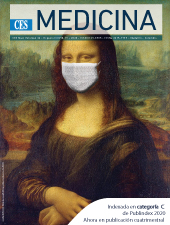Acute respiratory distress syndrome in times of the COVID-19 pandemic
DOI:
https://doi.org/10.21615/cesmedicina.34.COVID-19.10Keywords:
Acute Respiratory Distress Syndrome, pneumonia, mechanical ventilation, SARS-CoV2, COVID-19Abstract
Background: Acute respiratory distress syndrome (ARDS) is a frequent entity in critical care with significant morbidity and mortality. Recently, it has gained relevance due to the pandemic caused by SARS-CoV2 infection, in which large numbers of patients have required mechanical ventilation and treatment for a secondary ARDS. Anticipating the need for a redistribution of human health resources, we conducted a narrative review on Acute Respiratory Distress Syndrome (ARDS) with the main articles related to management of this clinical entity. Methods: Databases (PubMed, MEDLINE, Lilacs) were searched for relevant literature including multidisciplinary texts, clinical practice guidelines and clinical studies written in English and Spanish until April 2020. Results: The main measures related to decreased mortality are protective ventilation and prone ventilation. Some therapeutic strategies, such as restrictive fluid management, have not been shown to impact mortality but rather secondary events. The use of extracorporeal oxygenation membrane has not been shown to decrease mortality. Conclusions: Acute respiratory distress syndrome is the most frequent severe manifestation of infection with SARS-CoV2. Therapeutic strategies are mandatory knowledge for professionals who face a patient with COVID-19. Few strategies impact mortality and secondary events, including protective mechanical ventilation and prone ventilation. ECMO continues to be considered a compassionate measure.
Downloads
References
Ashbaugh DG, Bigelow DB, Petty TL, Levine BE. Acute respiratory distress in adults. Lancet. 1967;2(7511):319-23.
Pelosi P, Gattinoni L. Acute respiratory distress syndrome of pulmonary and extra-pulmonary origin: fancy or reality? Intensive Care Med. 2001;27(3):457-60.
Mikkelsen ME; Lanken PN; Christie JD. Acute Lung Injury and the Acute Respiratory Distress Syndrome. En: Jesse B. Hall, editor. Principles of critical care. 4. ed. New York: McGraw-Hill Education; 2015. (Critical care).
Casey JD, Ware LB. What are the pathologic and pathophysiologic changes that accompany ARDS? En: Evidence-Based Practice of Critical Care. 3rd Edition. Elsevier; 2020. p. 95-102.
Matthay MA, Wiener-Kronish JP. Intact epithelial barrier function is critical for the resolution of alveolar edema in humans. Am Rev Respir Dis. 1990;142(6 Pt 1):1250-7.
The ARDS Definition Task Force, Ranieri VM, Rubenfeld GD, Thompson BT, Ferguson ND, Caldwell E, Fan E, Camporota L, Slutsky AS. Acute Respiratory Distress Syndrome: The Berlin Definition. JAMA. 2012;307(23):2526-33.
Kempker JA, Martin GS. What lessons have we learned from epidemiologic studies of ARDS? En: Evidence-Based Practice of Critical Care. 3rd Edition. Elsevier; 2020. p. 149-54.
Bellani G, Laffey JG, Pham T, Fan E, Brochard L, Esteban A, et al. Epidemiology, Patterns of Care, and Mortality for Patients With Acute Respiratory Distress Syndrome in Intensive Care Units in 50 Countries. JAMA. 2016;315(8):788.
Huang C, Wang Y, Li X, Ren L, Zhao J, Hu Y, et al. Clinical features of patients infected with 2019 novel coronavirus in Wuhan, China. Lancet. 2020;395(10223):497-506.
Neto AS, Barbas CSV, Simonis FD, Artigas-Raventós A, Canet J, Determann RM, et al. Epidemiological characteristics, practice of ventilation, and clinical outcome in patients at risk of acute respiratory distress syndrome in intensive care units from 16 countries (PRoVENT): an international, multicentre, prospective study. Lancet Respir Med. 2016;4(11):882-93.
Tang X, Du R, Wang R, Cao T, Guan L, Yang C, et al. Comparison of Hospitalized Patients with Acute Respiratory Distress Syndrome Caused by COVID-19 and H1N1. Chest. 2020;
Gattinoni L, Coppola S, Cressoni M, Busana M, Chiumello D. Covid-19 Does Not Lead to a «Typical» Acute Respiratory Distress Syndrome. Am J Respir Crit Care Med. 2020;
Gattinoni L, Chiumello D, Caironi P, Busana M, Romitti F, Brazzi L, et al. COVID-19 pneumonia: different respiratory treatments for different phenotypes? Intensive Care Med [Internet]. 14 de abril de 2020 [citado 8 de junio de 2020]; Disponible en: http://link.springer.com/10.1007/s00134-020-06033-2
Ñamendys-Silva SA. ECMO for ARDS due to COVID-19. Heart Lung. 2020
Alhazzani W, Møller MH, Arabi YM, Loeb M, Gong MN, Fan E, et al. Surviving Sepsis Campaign: guidelines on the management of critically ill adults with Coronavirus Disease 2019 (COVID-19). Intensive Care Med. 2020;
Chica-Meza C, Peña-López LA, Villamarín-Guerrero HF, Moreno-Collazos JE, Rodríguez-Corredor LC, Lozano WM, et al. Cuidado Respiratorio En Covid-19. Acta Colomb Cuid Intensivo. 2020;
National Heart, Lung, and Blood Institute (ARDS) Clinical Trials Network, Wiedeman, Hebert P, Wheeler, Arthur P, Bernard, Gordon R, Thompson, B Taylor, Hayden, Douglas, et al. Comparison of Two Fluid-Management Strategies in Acute Lung Injury. N Engl J Med. 2006;354(24):2564-75.
Meduri GU, Belenchia JM, Estes RJ, Wunderink RG, Torky ME, Leeper KV. Fibroproliferative Phase of ARDS. Chest. 1991;100(4):943-52.
Arabi YM, Mandourah Y, Al-Hameed F, Sindi AA, Almekhlafi GA, Hussein MA, et al. Corticosteroid Therapy for Critically Ill Patients with Middle East Respiratory Syndrome. Am J Respir Crit Care Med. 2018;197(6):757-67.
Delaney JW, Pinto R, Long J, Lamontagne F, Adhikari NK, Kumar A, et al. The influence of corticosteroid treatment on the outcome of influenza A(H1N1pdm09)-related critical illness. Crit Care. 2016;20:75.
Taiwan Severe Influenza Research Consortium (TSIRC) Investigators, Tsai M-J, Yang K-Y, Chan M-C, Kao K-C, Wang H-C, et al. Impact of corticosteroid treatment on clinical outcomes of influenza-associated ARDS: a nationwide multicenter study. Ann Intensive Care. 2020;10(1):26.
Russell CD, Millar JE, Baillie JK. Clinical evidence does not support corticosteroid treatment for 2019-nCoV lung injury. The Lancet. 2020;395(10223):473-5.
The RECOVERY Collaborative Group. Dexamethasone in Hospitalized Patients with Covid-19 — Preliminary Report. N Engl J Med [Internet]. 2020 [citado 27 de julio de 2020]; Disponible en: https://doi.org/10.1056/NEJMoa2021436
Gattinoni L, Pesenti A. The concept of «baby lung». Intensive Care Med. 2005;31(6):776-84.
Acute Respiratory Distress Syndrome Network, Brower RG, Matthay MA, Morris A, Schoenfeld D, Thompson BT, et al. Ventilation with lower tidal volumes as compared with traditional tidal volumes for acute lung injury and the acute respiratory distress syndrome. N Engl J Med. 2000;342(18):1301-8.
Yasin A. Khan y Niall D. Ferguson. What is the best mechanical ventilation strategy in ARDS? En: Evidence-Based Practice of Critical Care. 3rd Edition. Elsevier; 2020. p. 109-20.
Papazian L, Aubron C, Brochard L, Chiche J-D, Combes A, Dreyfuss D, et al. Formal guidelines: management of acute respiratory distress syndrome. Ann Intensive Care. 2019;9(1):69.
Cressoni M, Chiumello D, Algieri I, Brioni M, Chiurazzi C, Colombo A, et al. Opening pressures and atelectrauma in acute respiratory distress syndrome. Intensive Care Med. 2017;43(5):603-11.
Xirouchaki N, Magkanas E, Vaporidi K, Kondili E, Plataki M, Patrianakos A, et al. Lung ultrasound in critically ill patients: comparison with bedside chest radiography. Intensive Care Med. 2011;37(9):1488-93.
Asociación Colombiana de Medicina Crítica y Cuidado Intensivo. Declaración del Consenso en Medicina Crítica para la atención multidisciplinaria del paciente con sospecha o confirmación diagnóstica Covid-19 [Internet]. 2020. Disponible en: http://www.amci.org.co/consenso-covid19
Taccone P, Pesenti A, Latini R, Polli F, Vagginelli F, Mietto C, et al. Prone positioning in patients with moderate and severe acute respiratory distress syndrome: a randomized controlled trial. JAMA. 2009;302(18):1977-84.
Munshi L, Del Sorbo L, Adhikari NKJ, Hodgson CL, Wunsch H, Meade MO, et al. Prone Position for Acute Respiratory Distress Syndrome. A Systematic Review and Meta-Analysis. Ann Am Thorac Soc. 2017;14(S4):280-8.
Papazian L, Forel J-M, Gacouin A, Penot-Ragon C, Perrin G, Loundou A, et al. Neuromuscular Blockers in Early Acute Respiratory Distress Syndrome. N Engl J Med. 2010;363(12):1107-16.
Hong X, Xiong J, Feng Z, Shi Y. Extracorporeal membrane oxygenation (ECMO): does it have a role in the treatment of severe COVID-19? Int J Infect Dis. 2020;(94):78-80.
Downloads
Published
How to Cite
Issue
Section
License
Copyright (c) 2020 CES Medicina

This work is licensed under a Creative Commons Attribution-NonCommercial-ShareAlike 4.0 International License.
Derechos de reproducción (copyright)
Cada manuscrito se acompañará de una declaración en la que se especifique que los materiales son inéditos, que no han sido publicados anteriormente en formato impreso o electrónico y que no se presentarán a ningún otro medio antes de conocer la decisión de la revista. En todo caso, cualquier publicación anterior, sea en forma impresa o electrónica, deberá darse a conocer a la redacción por escrito.
Plagios, duplicaciones totales o parciales, traduccones del original a otro idioma son de responsabilidad exclusiva de los autores el envío.
Los autores adjuntarán una declaración firmada indicando que, si el manuscrito se acepta para su publicación, los derechos de reproducción son propiedad exclusiva de la Revista CES Medicina.
Se solicita a los autores que proporcionen la información completa acerca de cualquier beca o subvención recibida de una entidad comercial u otro grupo con intereses privados, u otro organismo, para costear parcial o totalmente el trabajo en que se basa el artículo.
Los autores tienen la responsabilidad de obtener los permisos necesarios para reproducir cualquier material protegido por derechos de reproducción. El manuscrito se acompañará de la carta original que otorgue ese permiso y en ella debe especificarse con exactitud el número del cuadro o figura o el texto exacto que se citará y cómo se usará, así como la referencia bibliográfica completa.
| Article metrics | |
|---|---|
| Abstract views | |
| Galley vies | |
| PDF Views | |
| HTML views | |
| Other views | |



